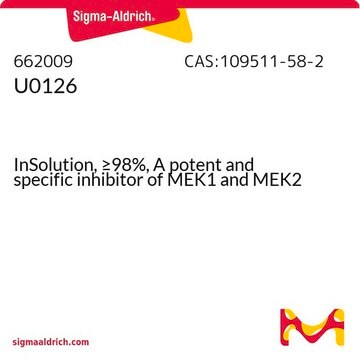추천 제품
생물학적 소스
rabbit
Quality Level
항체 형태
affinity isolated antibody
항체 생산 유형
primary antibodies
클론
polyclonal
정제법
affinity chromatography
종 반응성
human
기술
immunohistochemistry: suitable (paraffin)
western blot: suitable
NCBI 수납 번호
UniProt 수납 번호
배송 상태
ambient
타겟 번역 후 변형
unmodified
유전자 정보
human ... PCK1(5105)
일반 설명
Phosphoenolpyruvate carboxykinase, cytosolic (UniProt: also known as PEPCK, PEPCK-C) is encoded by the PCK1 (also known as PEPCK1) gene (Gene ID: 5105) in human. PEPCK catalyzes the conversion of oxaloacetate (OAA) to phosphoenolpyruvate (PEP), which is a rate-limiting step in gluconeogenesis. It requires manganese as a cofactor. It is expressed in higher levels in liver of fasting subjects. Kidney and adipocytes exhibit lower expression levels. Two isozymes of PEPCK have been identified, cytosolic and mitochondrial. PEPCK consists of an N-terminal and a catalytic C-terminal domain, with the active site and metal ions located in a cleft between them. Upon binding to substrate, PEPCK undergoes a conformational change that accelerates the catalysis process. Expression of PEPCK can be controlled by cAMP, glucocorticoids, and by insulin. Its expression is induced by glucagon, catecholamines, and glucocorticoids during periods of fasting and in response to stress and is diminished following glucose-induced and by the action of insulin. PEPCK-C is absent in fetal liver but appears at birth, concomitant with the capacity for gluconeogenesis. Deficiency of PEPCK-C is a rare metabolic disorder results in fatty infiltration of liver and kidney, hypoglycemia, hepatomegaly, and failure to thrive.
특이성
This polyclonal antibody detects cytosolic phosphoenolpyruvate carboxykinase in human kidney.
면역원
KLH-conjugated linear peptide corresponding to 15 amino acids from the C-terminal half of human phosphoenolpyyruvate carboxykinase (PEPCK).
애플리케이션
Detect Phosphoenolpyruvate carboxykinase, cytosolic [GTP] using this rabbit polyclonal Anti-PEPCK, Cat. No. ABC1691, tested in Immunohistochemistry (Paraffin) and Western Blotting.
Immunohistochemistry Analysis: A 1:1,000 dilution from a representative lot detected PEPCK in human kidney, human pancreas, human skeletal muscle, and human placental tissue.
Western Blotting Analysis: 2 µg/mL from a representative lot detected PEPCK in 10 µg of human kidney tissue.
Western Blotting Analysis: 2 µg/mL from a representative lot detected PEPCK in 10 µg of human kidney tissue.
Research Category
Apoptosis & Cancer
Apoptosis & Cancer
품질
Evaluated by Immunohistochemistry in human liver tissue
Immunohistochemistry Analysis: A 1:1,000 dilution of this antibody detected PEPCK in human liver tissue.
Immunohistochemistry Analysis: A 1:1,000 dilution of this antibody detected PEPCK in human liver tissue.
표적 설명
~65 kDa observed; 69.19 kDa calculated. Uncharacterized bands may be observed in some lysate(s).
물리적 형태
Affinity Purified
Purified rabbit polyclonal antibody in buffer containing 0.1 M Tris-Glycine (pH 7.4), 150 mM NaCl with 0.05% sodium azide.
저장 및 안정성
Stable for 1 year at 2-8°C from date of receipt.
기타 정보
Concentration: Please refer to lot specific datasheet.
면책조항
Unless otherwise stated in our catalog or other company documentation accompanying the product(s), our products are intended for research use only and are not to be used for any other purpose, which includes but is not limited to, unauthorized commercial uses, in vitro diagnostic uses, ex vivo or in vivo therapeutic uses or any type of consumption or application to humans or animals.
Not finding the right product?
Try our 제품 선택기 도구.
Storage Class Code
12 - Non Combustible Liquids
WGK
WGK 1
시험 성적서(COA)
제품의 로트/배치 번호를 입력하여 시험 성적서(COA)을 검색하십시오. 로트 및 배치 번호는 제품 라벨에 있는 ‘로트’ 또는 ‘배치’라는 용어 뒤에서 찾을 수 있습니다.
Su-Ryun Jung et al.
The Korean journal of physiology & pharmacology : official journal of the Korean Physiological Society and the Korean Society of Pharmacology, 28(1), 31-38 (2023-12-29)
As in type 1 diabetes, the loss of pancreatic β-cells leads to insulin deficiency and the subsequent development of hyperglycemia. Exercise has been proposed as a viable remedy for hyperglycemia. Lithium, which has been used as a treatment for bipolar
자사의 과학자팀은 생명 과학, 재료 과학, 화학 합성, 크로마토그래피, 분석 및 기타 많은 영역을 포함한 모든 과학 분야에 경험이 있습니다..
고객지원팀으로 연락바랍니다.








